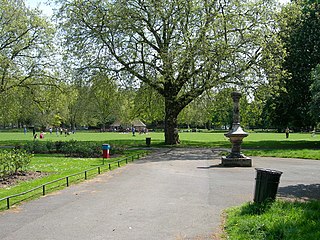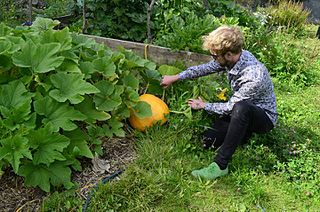
Squatting is the action of occupying an abandoned or unoccupied area of land or a building, usually residential, that the squatter does not own, rent or otherwise have lawful permission to use. The United Nations estimated in 2003 that there were one billion slum residents and squatters globally. Squatting occurs worldwide and tends to occur when people who are poor and homeless find empty buildings or land to occupy for housing. It has a long history, broken down by country below.

Kennington is a district in south London, England. It is mainly within the London Borough of Lambeth, running along the boundary with the London Borough of Southwark, a boundary which can be discerned from the early medieval period between the Lambeth and St George's parishes of those boroughs respectively. It is located 1.4 miles (2.3 km) south of Charing Cross in Inner London and is identified as a local centre in the London Plan. It was a royal manor in the parish of St Mary, Lambeth in the county of Surrey and was the administrative centre of the parish from 1853. Proximity to central London was key to the development of the area as a residential suburb and it was incorporated into the metropolitan area of London in 1855.

De Blauwe Aanslag was a squat and self-managed social centre in the Dutch city of The Hague. The oldest part of the building was built in 1886. The large building formerly housed tax offices and was occupied in 1980. When the local council took over the ownership of the building, it was agreed to renovate it in three stages, with the squatters living there. However the plans changed and since 1995 the council decided to widen the roads next to the building; for this reason the squat needed to be demolished. After many efforts to block the demolition with lawsuits, the squatters were evicted by military police on 3 October, 2003.

Kennington Park is a public park in Kennington, south London and lies between Kennington Park Road and St. Agnes Place. It was opened in 1854 on the site of what had been Kennington Common, where the Chartists gathered for their biggest "monster rally" on 10 April 1848. Soon after this demonstration the common was enclosed and, sponsored by the royal family, made into a public park.

Villa Amalia is the name of the building that hosted the former Second High School of Athens in Greece. It is located on the corner of Acharnon and Heiden streets, near Victoria metro station. It was an anarchist squat before its eviction in 2012. It reopened as a school in 2016.
London Street Commune was a hippy movement formed during the 1960s. It aimed to highlight concerns about rising levels of homelessness and to house the hundreds of hippies sleeping in parks and derelict buildings in central London.
Jack Tafari was a sometimes homeless Rastafari activist who advocated for himself and other homeless people, in the US and the UK. He was best known for promoting "sanctioned tent cities" as transitional housing for homeless people, including himself, in Portland, Oregon, United States.
The Advisory Service for Squatters (A.S.S.) is a non-profit group based in London and run by volunteers. It aims to provide practical advice and legal support for squatters. It was founded in 1975, having grown out of the Family Squatters Advisory Service. After being based for many years in St. Paul's Road in Islington, A.S.S. moved its offices to Whitechapel High Street, in the same building as Freedom Press.
The Frances Street Squats were a set of six squatted houses, including one women-only building, that existed between February and November 1990 in Vancouver, Canada. They were occupied by SAVE and took a stand against development which was generally supported by local people. The Vancouver Police Department evicted the buildings.

Squatting in England and Wales usually refers to a person who is not the owner, taking possession of land or an empty house. People squat for a variety of reasons which include needing a home, protest, poverty, and recreation. Many squats are residential, some are also opened as social centres. Land may be occupied by New Age travellers or treesitters.
Squatting in the United States is the unauthorized use of real estate. Historically, squatting occurred during the California Gold Rush and when colonial European settlers established land rights. There was squatting during the Great Depression in Hoovervilles and also during World War II. Shanty towns returned to the US after the Great Recession of 2007 to 2009 and in the 2010s, there have been increasing numbers of people squatting foreclosed homes using fraudulent documents. In some cases, a squatter may be able to obtain ownership of property through adverse possession.

Argyle Street was a Victorian terraced street in Norwich, Norfolk. It became a squat lasting from 1979 to 1985. The street was then demolished in 1986. Some of the newbuild houses were subsequently demolished in 2015.

Squat Milada is a First Republic villa located in the Libeň district of Prague. Milada was intended to be demolished in the 1980s and thus deleted from the cadastre, becoming a house which officially did not exist. It became one of the Czech Republic's best known squats, occupied from 1997 until 2009. It was then reoccupied for a day in 2012. Acting as a self-managed social centre and infoshop hosting concerts and events, Milada was also home to a number of people. Despite various plans for the site, as of 2019, the building was standing derelict.

The 2016 Bendigo Street housing dispute concerned a series of occupations of houses in Collingwood, Melbourne, Australia. The properties were owned by the Victorian Government which had made aborted plans to construct the East West Link road. The houses, mostly on Bendigo Street, became the centre of a lengthy dispute between the government, Victoria Police and the Homeless Persons Union.
Umbrella House is a former squat and a Housing Development Fund Corporation in New York City's East Village, at 21-23 Avenue C. The squat, formed in 1988, was known for its political engagement and high level of collective organization among its members. In 2010, the building officially became a housing cooperative.

Grow Heathrow is a land squat and community garden in Sipson, west London. It was occupied in 2010 by local people concerned about the possibility of the expansion of Heathrow Airport. It is part of the Transition Network. Half of the site was evicted in 2019.

Squatting in Australia usually refers to a person who is not the owner, taking possession of land or an empty house. In 19th century Australian history, a squatter was a settler who occupied a large tract of Aboriginal land in order to graze livestock. At first this was done illegally, later under licence from the Crown.

Squatting in the Republic of Ireland is the occupation of unused land or derelict buildings without the permission of the owner. In the 1960s, the Dublin Housing Action Committee highlighted the housing crisis by squatting buildings. From the 1990s onwards there have been occasional political squats such as Grangegorman.

Squatting in the Netherlands is the occupation of unused or derelict buildings or land without the permission of the owner. The modern squatters movement began in the 1960s in the Netherlands. By the 1980s, it had become a powerful anarchist social movement which regularly came into conflict with the state, particularly in Amsterdam with the Vondelstraat and coronation riots.

Oval Mansions are eight separate blocks of tenement housing in Kennington, south London. The blocks stand between the Oval cricket ground and the Oval Gasholders. After being occupied by one hundred squatters from 1983 until 2000, the buildings were sold off by Lambeth Council in the early 2000s.
















